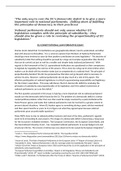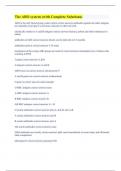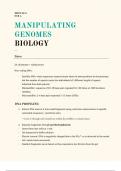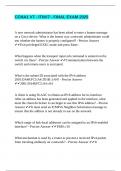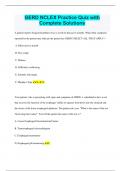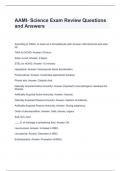MNM3702
NOTES
, STUDY UNIT 1 – ROLE OF MARKETING RESEARCH
DEFINING MARKETING
Marketing can be defined as those decisions made in a business organisation about whom to serve with what
product. The definition refers to two decision making areas:
Demarcating the enterprise’s potential consumers into market segments and to decide which of these
market segments to choose as a target market.
Developing a total product consisting of the actual product, the distribution to the target market,
marketing the product to the consumers by means of advertising and determining the price that will
be acceptable to the target market. These four components - product, price, promotion and place -
are known as the marketing mix.
To determine the enterprise’s strengths and weaknesses, the opportunities open to the enterprise and the
threats that it will face, an analysis of the business environment needs to be conducted. This is where
“marketing research” comes into play. The analysis of the marketing environment is also called a “situation
analysis”
DEFINING MARKETING RESEARCH
Marketing research can be defined as the systematic collection, analysis and interpretation of information
about all marketing problems by means of recognized scientific methods to provide information that
marketing management can use in the decision-making process.
THE CHARACTERISTICS OF MARKETING RESEARCH:
Quantitative vs. Qualitative - Can be scrutinized mathematically. Determining the effect which an
increase in the fuel price would have on the consumption of the organization’s product is qualitative
in nature.
Applied vs. Basic Research - Is aimed at analysing an opportunity or a threat in the marketplace. The
research findings can be applied to take advantage of the opportunity, or to address the threat in the
marketing environment. Basic research is aimed at extending knowledge. For example – Years ago
research was initiated to find alternative fuels to petrol. Hydrogen was one of these alternatives =
basic research. Later on, motor vehicle manufacturers started to developed a hydrogen-powered car
= applied research.
Inaccurate vs. Accurate - Marketing research findings can be highly accurate or fairly accurate. For
example – Analysing the colour preferences of a firm’s consumers can result in accurate data
regarding the need for each colour. Estimating the drop in sales when a firm decreases its advertising
expenditure cannot be accurate.
Time vs. Budget Constraints - Most research ventures are aimed at addressing threats or
opportunities which require rapid response. An elaborate research design and extensive fieldwork is
time consuming and NOT possible. Visiting 300 consumers (respondents) at home and asking them
about their usage of our product is a costly exercise.
THE ROLE OF MARKETING RESEARCH IN THE MARKETING MANAGEMENT PROCESS
Marketing research is not only conducted as part of the situational analysis, it is also utilized in three phases of
the marketing management process.
Who we plan to serve the target market with a specific product (marketing mix – 4 P’s)
The marketing strategy is formulated by addressing two decisions
I. Defining served market segments.
II. Establishing the competitive advantage of the product.
, The development of the marketing mix programes (4 P’s). The final phase of the marketing planning
process is the control phase during which the results of the marketing programmes are evaluated
against the objectives that were set for them.
Marketing plays 3 functional roles in marketing decision making:
DESCRIPTIVE – gathering and presenting statements and facts
DIAGNOSTIC- Explaining of data or actions
PREDICTIVE – Specification of how to use descriptive and diagnostic
BENEFITS OF MARKETING RESEARCH
Marketing research offers a range of benefits to marketers:
It helps managers in decision-making, because they can be proactive by anticipating changes in the
market and in consumer desires.
It helps a manager to present a more accurate definition of marketing problems and opportunities.
It offers a reliable method of prediction.
It provides the company with a competitive edge.
It results in more efficient expenditure.
Business risk can be reduced.
The effectiveness of the marketing plan can be monitored.
STUDY UNIT 2: MARKETING INFORMATION SYSTEMS (MIS)
With so much marketing information available to the marketer, a way has to be found to organise this
information so it can be readily accessed for use in decision making. The rapid growth of information has
made the task easier because computers can now be used to store and organise this information.
A marketing information system can be defined as:
A set of inter-related components that collect (or retrieve), process, store and distribute information to
support decision making and control in an organisation.
Three types of information can be extracted:
Recurrent information: Information that is continuously provided to managers. For example: weekly
sales figures per product or per region.
Monitoring information: Information obtained from sources relevant to the particular company of
industry. For example: internet websites or trade publications.
Requester information: Specific information that is requested and then collected as part of a specific
query from marketing management.
THE VALUE OF MARKETING INFORMATION
For a marketing information system to be of any use, Information must be of high quality and add value to the
decision making process therefore very important to ensure that information meets the following criteria.
Relevant (meaningful): Management must be able to use the information to make decisions about
target markets, products, prices, distribution and marketing communication. Must be suitable for
solving the problem on hand.
Useful: It must be made available in a form that the user can understand and apply.
Timeous: Must be available on a continuous basis (whenever decision must be made) and up to date.
Accurate: Must reflect the realities of the situation in which the organisation is operating and the
problems being experienced.
Adequate: Sufficient qualitative and quantitative information.
Available: Should be in a form that is easy to access.
Collecting information and operating MIS (marketing information system) has a cost component consist of
direct costs and opportunity costs. Direct costs refer to the collection and management of information.
Opportunity costs refer, for example, to costs arising from a decision that was delayed because of a lack of
information.
, OBJECTIVES OF AN MIS
The primary objective of an MIS is to make relevant, useful, timeous information available to marketing
management on a continuous basis and in so doing, reduce the risk of making wrong decisions.
The secondary objective of an MIS will vary according to the nature of the organisation and the products and /
or services offered on the market. They may include:
To identify shortcomings.
To distribute marketing activities more effectively.
To identify the need for new products and provide information.
To determine prices in order to remain competitive.
To motivate sales staff.
TYPES OF MARKETING INFORMATION SYSTEMS
The type of MIS in an organisation will depend on its size and the industry in which it operates. A simple MIS
consist of a routine data component and a special purpose component. Routine data can be obtained from
internal sources (sales, stock, debtors and creditors) and external sources (population growth, competitive
activities). For the special purpose component, marketing research must be conducted. If the establishment
itself conducts it, it is called internal research. Research undertaken by a marketing research agent is referred
to as external research.
COMPONENTS OF AN MIS
1. The internal reporting subsystem: Such information is gathered by way of internal reports from
within the organisation. They may include: sales reports, stock records, debtors and creditors
statements. Most valuable information comes from sales invoices, sales force information and
accounting information. The internal reporting subsystem contains information about the
organisation’s past results and used for identifying opportunities and threats.
2. The marketing intelligence subsystem: The internal reporting subsystem focuses on results and
marketing intelligence focuses on happenings. It is set of procedures and sources used to acquire the
information. Can be obtained by personnel who are assigned to look for anything that seems
pertinent to the organisation or by scanning newspapers, magazines and trade publications.
3. The statistical subsystem: Combines various statistical data series and the application of statistical
models. Information from the databases is processed statistically to develop certain predictions,
scenarios and models that decrease the risk of decision making.
4. The marketing research subsystem: Marketing research is the collection, analysis and interpretation
of information about specific marketing matters. This system is used only when specific information is
needed.
5. Marketing decision support system (MDSS). The purpose of a statistical subsystem is to combine
marketing data from diverse sources into a single database which marketing managers can enter
interactively to identify problems and opportunities and then obtain standard, periodic reports and
answers to analytical questions.
An MDSS defined as:
A co-ordinated collection of data, systems, tools and techniques with supporting software and hardware by
which an organisation gathers and interprets relevant information from business and the environment and
turns it into a basis for marketing decisions.
CHARACTERISTICS OF A GOOD MDSS:
Interactive. System should be easy to use by the user.
Flexible. System should be able to provide information in different forms according to the needs of
the user.
Discovery oriented. The user should be able to use the system to identify new trends or patterns and
then to ask new questions based on these trends or patterns.
User friendly. Should be easy to understand and use and not be a source of frustration to the user.
THE MDSS CONSISTS OF THE FOLLOWING COMPONENTS:
NOTES
, STUDY UNIT 1 – ROLE OF MARKETING RESEARCH
DEFINING MARKETING
Marketing can be defined as those decisions made in a business organisation about whom to serve with what
product. The definition refers to two decision making areas:
Demarcating the enterprise’s potential consumers into market segments and to decide which of these
market segments to choose as a target market.
Developing a total product consisting of the actual product, the distribution to the target market,
marketing the product to the consumers by means of advertising and determining the price that will
be acceptable to the target market. These four components - product, price, promotion and place -
are known as the marketing mix.
To determine the enterprise’s strengths and weaknesses, the opportunities open to the enterprise and the
threats that it will face, an analysis of the business environment needs to be conducted. This is where
“marketing research” comes into play. The analysis of the marketing environment is also called a “situation
analysis”
DEFINING MARKETING RESEARCH
Marketing research can be defined as the systematic collection, analysis and interpretation of information
about all marketing problems by means of recognized scientific methods to provide information that
marketing management can use in the decision-making process.
THE CHARACTERISTICS OF MARKETING RESEARCH:
Quantitative vs. Qualitative - Can be scrutinized mathematically. Determining the effect which an
increase in the fuel price would have on the consumption of the organization’s product is qualitative
in nature.
Applied vs. Basic Research - Is aimed at analysing an opportunity or a threat in the marketplace. The
research findings can be applied to take advantage of the opportunity, or to address the threat in the
marketing environment. Basic research is aimed at extending knowledge. For example – Years ago
research was initiated to find alternative fuels to petrol. Hydrogen was one of these alternatives =
basic research. Later on, motor vehicle manufacturers started to developed a hydrogen-powered car
= applied research.
Inaccurate vs. Accurate - Marketing research findings can be highly accurate or fairly accurate. For
example – Analysing the colour preferences of a firm’s consumers can result in accurate data
regarding the need for each colour. Estimating the drop in sales when a firm decreases its advertising
expenditure cannot be accurate.
Time vs. Budget Constraints - Most research ventures are aimed at addressing threats or
opportunities which require rapid response. An elaborate research design and extensive fieldwork is
time consuming and NOT possible. Visiting 300 consumers (respondents) at home and asking them
about their usage of our product is a costly exercise.
THE ROLE OF MARKETING RESEARCH IN THE MARKETING MANAGEMENT PROCESS
Marketing research is not only conducted as part of the situational analysis, it is also utilized in three phases of
the marketing management process.
Who we plan to serve the target market with a specific product (marketing mix – 4 P’s)
The marketing strategy is formulated by addressing two decisions
I. Defining served market segments.
II. Establishing the competitive advantage of the product.
, The development of the marketing mix programes (4 P’s). The final phase of the marketing planning
process is the control phase during which the results of the marketing programmes are evaluated
against the objectives that were set for them.
Marketing plays 3 functional roles in marketing decision making:
DESCRIPTIVE – gathering and presenting statements and facts
DIAGNOSTIC- Explaining of data or actions
PREDICTIVE – Specification of how to use descriptive and diagnostic
BENEFITS OF MARKETING RESEARCH
Marketing research offers a range of benefits to marketers:
It helps managers in decision-making, because they can be proactive by anticipating changes in the
market and in consumer desires.
It helps a manager to present a more accurate definition of marketing problems and opportunities.
It offers a reliable method of prediction.
It provides the company with a competitive edge.
It results in more efficient expenditure.
Business risk can be reduced.
The effectiveness of the marketing plan can be monitored.
STUDY UNIT 2: MARKETING INFORMATION SYSTEMS (MIS)
With so much marketing information available to the marketer, a way has to be found to organise this
information so it can be readily accessed for use in decision making. The rapid growth of information has
made the task easier because computers can now be used to store and organise this information.
A marketing information system can be defined as:
A set of inter-related components that collect (or retrieve), process, store and distribute information to
support decision making and control in an organisation.
Three types of information can be extracted:
Recurrent information: Information that is continuously provided to managers. For example: weekly
sales figures per product or per region.
Monitoring information: Information obtained from sources relevant to the particular company of
industry. For example: internet websites or trade publications.
Requester information: Specific information that is requested and then collected as part of a specific
query from marketing management.
THE VALUE OF MARKETING INFORMATION
For a marketing information system to be of any use, Information must be of high quality and add value to the
decision making process therefore very important to ensure that information meets the following criteria.
Relevant (meaningful): Management must be able to use the information to make decisions about
target markets, products, prices, distribution and marketing communication. Must be suitable for
solving the problem on hand.
Useful: It must be made available in a form that the user can understand and apply.
Timeous: Must be available on a continuous basis (whenever decision must be made) and up to date.
Accurate: Must reflect the realities of the situation in which the organisation is operating and the
problems being experienced.
Adequate: Sufficient qualitative and quantitative information.
Available: Should be in a form that is easy to access.
Collecting information and operating MIS (marketing information system) has a cost component consist of
direct costs and opportunity costs. Direct costs refer to the collection and management of information.
Opportunity costs refer, for example, to costs arising from a decision that was delayed because of a lack of
information.
, OBJECTIVES OF AN MIS
The primary objective of an MIS is to make relevant, useful, timeous information available to marketing
management on a continuous basis and in so doing, reduce the risk of making wrong decisions.
The secondary objective of an MIS will vary according to the nature of the organisation and the products and /
or services offered on the market. They may include:
To identify shortcomings.
To distribute marketing activities more effectively.
To identify the need for new products and provide information.
To determine prices in order to remain competitive.
To motivate sales staff.
TYPES OF MARKETING INFORMATION SYSTEMS
The type of MIS in an organisation will depend on its size and the industry in which it operates. A simple MIS
consist of a routine data component and a special purpose component. Routine data can be obtained from
internal sources (sales, stock, debtors and creditors) and external sources (population growth, competitive
activities). For the special purpose component, marketing research must be conducted. If the establishment
itself conducts it, it is called internal research. Research undertaken by a marketing research agent is referred
to as external research.
COMPONENTS OF AN MIS
1. The internal reporting subsystem: Such information is gathered by way of internal reports from
within the organisation. They may include: sales reports, stock records, debtors and creditors
statements. Most valuable information comes from sales invoices, sales force information and
accounting information. The internal reporting subsystem contains information about the
organisation’s past results and used for identifying opportunities and threats.
2. The marketing intelligence subsystem: The internal reporting subsystem focuses on results and
marketing intelligence focuses on happenings. It is set of procedures and sources used to acquire the
information. Can be obtained by personnel who are assigned to look for anything that seems
pertinent to the organisation or by scanning newspapers, magazines and trade publications.
3. The statistical subsystem: Combines various statistical data series and the application of statistical
models. Information from the databases is processed statistically to develop certain predictions,
scenarios and models that decrease the risk of decision making.
4. The marketing research subsystem: Marketing research is the collection, analysis and interpretation
of information about specific marketing matters. This system is used only when specific information is
needed.
5. Marketing decision support system (MDSS). The purpose of a statistical subsystem is to combine
marketing data from diverse sources into a single database which marketing managers can enter
interactively to identify problems and opportunities and then obtain standard, periodic reports and
answers to analytical questions.
An MDSS defined as:
A co-ordinated collection of data, systems, tools and techniques with supporting software and hardware by
which an organisation gathers and interprets relevant information from business and the environment and
turns it into a basis for marketing decisions.
CHARACTERISTICS OF A GOOD MDSS:
Interactive. System should be easy to use by the user.
Flexible. System should be able to provide information in different forms according to the needs of
the user.
Discovery oriented. The user should be able to use the system to identify new trends or patterns and
then to ask new questions based on these trends or patterns.
User friendly. Should be easy to understand and use and not be a source of frustration to the user.
THE MDSS CONSISTS OF THE FOLLOWING COMPONENTS:

